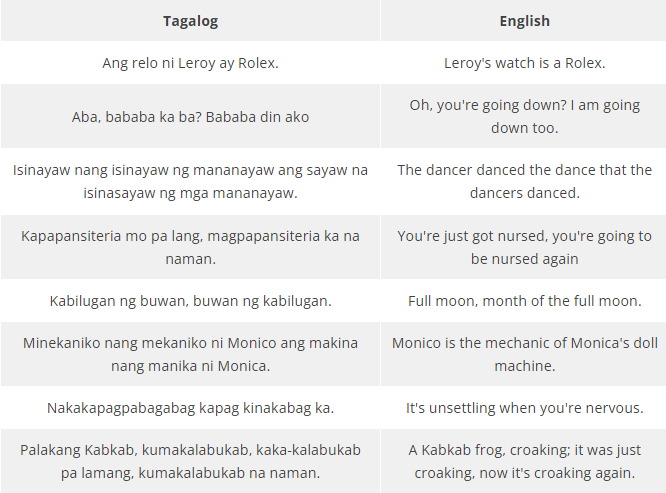Tagalog tongue twister: Tagalog tongue twisters, known as “Palindromong Balintataw,” are a fun and challenging way to enhance your language skills. In this blog, we’ll explore some tricky tongue twisters that will leave you tongue-tied and amused. If saying Tagalog words is a bit tricky for you, or if you simply want to know more about the main language of the Philippines, here’s a super easy way to begin!
This Blog Includes:

Origin of The Tagalog Tongue Twister
The origin of Tagalog tongue twisters, known as “Palindromong Balintataw,” can be traced back to the rich cultural and linguistic heritage of the Philippines. These tongue twisters have roots in the Filipino language and are crafted to play with the sounds, syllables, and nuances of Tagalog pronunciation.

Key Benefits of Tagalog Tongue Twister
A few benefits of Tagalog tongue twisters are defined below:
- The creation of Tagalog tongue twisters is likely influenced by a desire to celebrate linguistic diversity, encourage language play, and provide a fun way to enhance language skills.
- Filipino tongue twisters are very helpful in mastering the pronunciations of the most complex words.
- They are embraced not only as linguistic challenges but also as cultural artefacts that reflect the creativity and humour of the Filipino people.
- They are playful expressions of the Filipino language, contributing to the vibrant linguistic tapestry of the Philippines.
- They are not limited to boosting your pronunciation skills, but they also improve your mouth muscles and strengthen them too.

List of Tagalog Tongue Twisters You Should Know About!
Here is a list of some funny Tagalog twisters that will not only help to improve your pronunciation but also add more fun as you learn about the native language of the Philippines.





Tips to Learn Tagalog Tongue Twister
Learning tongue twisters like “Tagalog” can assist in improving your pronunciation, articulation, and overall fluency in a language in a funny manner. Here are some tips to help you master the “Tagalog ” tongue twister:
Start Slowly
Always start by saying the tongue twister slowly and clearly. Pay minute attention to each word and the sounds you are making.
Break it Down
Divide the tongue twister into smaller segments or phrases. It is advised to master one segment before moving on to the next.
Repeat Frequently
Repetition is key to success. Repeat the tongue twister for multiple times to build muscle memory and improve your speed.
Use a Mirror
Practice in front of a mirror to observe the movement of your lips, tongue, and mouth. This visual feedback can help you make necessary adjustments.
Focus on Problematic Sounds
Identify the sounds or combinations of sounds that are challenging for you. Practice those specific elements separately.

FAQs
Some popular tongue twisters in English are He threw three free throws, Fuzzy Wuzzy, and Eleven Benevolent Elephants.
Tagalog tongue twister is Ang relo ni Leroy ay Rolex.
Scissors and thistles
A happy hippo hopped and hiccupped.
A big black bug bit a big black bear
This was all about the Tagalog Tongue Twisters in English. Hope you understand the concept with fun examples and where it’s used. Keep an eye on Leverage Edu for more exciting and informative blogs.
 One app for all your study abroad needs
One app for all your study abroad needs














 45,000+ students realised their study abroad dream with us. Take the first step today.
45,000+ students realised their study abroad dream with us. Take the first step today.

